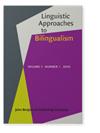Individual variation in contact effects – stability, convergence, and divergence
IF 1.8
2区 文学
0 LANGUAGE & LINGUISTICS
引用次数: 0
Abstract
In this study, we investigate the contact effects of stability, convergence, and divergence regarding the use of the same linguistic construction in the same contact situation. To do that, we collected experimental production and judgment data by native German speakers living in the Netherlands regarding their usage of the complementizer um ‘to’ in German and compared those data to those of a control group of German speakers not in contact with Dutch. The results show that most speakers show evidence for some contact-induced language change in their German. At the same time, speakers seem to experience different contact effects, demonstrating that it is not the structural properties of the construction that result in one effect over the other, but rather factors that pertain to the individual speakers. In particular, we argue that speakers can either focus on the similarities or on the differences between their languages, to some extent driven by their attitudes towards their languages and language change, and then over-generalize these similarities or differences to new contexts. Overall, this result clearly underlines the importance of focusing on individual speakers as the initiators of language change, which is in line with a usage-based approach.接触效应的个体差异--稳定性、趋同性和发散性
在本研究中,我们调查了在同一接触情景中使用同一语言结构时的稳定性、趋同性和差异性的接触效果。为此,我们收集了居住在荷兰的以德语为母语的人在德语中使用补语um "到 "时的实验性生产和判断数据,并将这些数据与未接触荷兰语的德语对照组的数据进行了比较。结果表明,大多数德语使用者的德语都出现了一些由接触引起的语言变化。与此同时,说话者似乎经历了不同的接触效果,这表明不是结构的结构属性导致了不同的效果,而是与说话者个体相关的因素。特别是,我们认为,在一定程度上,说话者对自己的语言和语言变化的态度会促使他们关注语言之间的相似点或不同点,然后将这些相似点或不同点过度概括到新的语境中。总之,这一结果清楚地表明,关注语言变化的发起者--说话者个人是非常重要的,这与以使用为基础的方法是一致的。
本文章由计算机程序翻译,如有差异,请以英文原文为准。
求助全文
约1分钟内获得全文
求助全文
来源期刊

Linguistic Approaches To Bilingualism
Social Sciences-Linguistics and Language
CiteScore
3.20
自引率
9.10%
发文量
24
期刊介绍:
LAB provides an outlet for cutting-edge, contemporary studies on bilingualism. LAB assumes a broad definition of bilingualism, including: adult L2 acquisition, simultaneous child bilingualism, child L2 acquisition, adult heritage speaker competence, L1 attrition in L2/Ln environments, and adult L3/Ln acquisition. LAB solicits high quality articles of original research assuming any cognitive science approach to understanding the mental representation of bilingual language competence and performance, including cognitive linguistics, emergentism/connectionism, generative theories, psycholinguistic and processing accounts, and covering typical and atypical populations.
 求助内容:
求助内容: 应助结果提醒方式:
应助结果提醒方式:


